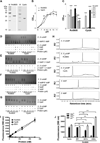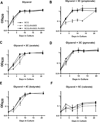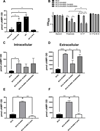Mycobacterial phosphodiesterase Rv0805 is a virulence determinant and its cyclic nucleotide hydrolytic activity is required for propionate detoxification
- PMID: 36760076
- PMCID: PMC10315211
- DOI: 10.1111/mmi.15030
Mycobacterial phosphodiesterase Rv0805 is a virulence determinant and its cyclic nucleotide hydrolytic activity is required for propionate detoxification
Abstract
Cyclic AMP (cAMP) signaling is essential to Mycobacterium tuberculosis (Mtb) pathogenesis. However, the roles of phosphodiesterases (PDEs) Rv0805, and the recently identified Rv1339, in cAMP homeostasis and Mtb biology are unclear. We found that Rv0805 modulates Mtb growth within mice, macrophages and on host-associated carbon sources. Mycobacterium bovis BCG grown on a combination of propionate and glycerol as carbon sources showed high levels of cAMP and had a strict requirement for Rv0805 cNMP hydrolytic activity. Supplementation with vitamin B12 or spontaneous genetic mutations in the pta-ackA operon restored the growth of BCGΔRv0805 and eliminated propionate-associated cAMP increases. Surprisingly, reduction of total cAMP levels by ectopic expression of Rv1339 restored only 20% of growth, while Rv0805 complementation fully restored growth despite a smaller effect on total cAMP levels. Deletion of an Rv0805 localization domain also reduced BCG growth in the presence of propionate and glycerol. We propose that localized Rv0805 cAMP hydrolysis modulates activity of a specialized pathway associated with propionate metabolism, while Rv1339 has a broader role in cAMP homeostasis. Future studies will address the biological roles of Rv0805 and Rv1339, including their impacts on metabolism, cAMP signaling and Mtb pathogenesis.
Keywords: TB complex bacteria; cAMP signaling; carbon metabolism; cyclic nucleotide phosphodiesterase.
© 2023 John Wiley & Sons Ltd.
Figures








Similar articles
-
The Rv0805 gene from Mycobacterium tuberculosis encodes a 3',5'-cyclic nucleotide phosphodiesterase: biochemical and mutational analysis.Biochemistry. 2005 Dec 6;44(48):15695-704. doi: 10.1021/bi0512391. Biochemistry. 2005. PMID: 16313172
-
Structural and biochemical analysis of the Rv0805 cyclic nucleotide phosphodiesterase from Mycobacterium tuberculosis.J Mol Biol. 2007 Jan 5;365(1):211-25. doi: 10.1016/j.jmb.2006.10.005. Epub 2006 Oct 6. J Mol Biol. 2007. PMID: 17059828
-
Overexpression of the Rv0805 phosphodiesterase elicits a cAMP-independent transcriptional response.Tuberculosis (Edinb). 2013 Sep;93(5):492-500. doi: 10.1016/j.tube.2013.05.004. Epub 2013 Jul 6. Tuberculosis (Edinb). 2013. PMID: 23835087 Free PMC article.
-
Revisiting bacterial cyclic nucleotide phosphodiesterases: cyclic AMP hydrolysis and beyond.FEMS Microbiol Lett. 2015 Nov;362(22):fnv183. doi: 10.1093/femsle/fnv183. Epub 2015 Sep 30. FEMS Microbiol Lett. 2015. PMID: 26424768 Review.
-
Cyclic nucleotide phosphodiesterase-mediated integration of cGMP and cAMP signaling in cells of the cardiovascular system.Front Biosci. 2005 May 1;10:1221-8. doi: 10.2741/1614. Front Biosci. 2005. PMID: 15769620 Review.
Cited by
-
Exploiting cAMP signaling in Mycobacterium tuberculosis for drug discovery.Trends Microbiol. 2024 Sep;32(9):874-883. doi: 10.1016/j.tim.2024.01.008. Epub 2024 Feb 14. Trends Microbiol. 2024. PMID: 38360432 Review.
-
Strategic targeting of AckA in Mycobacterium tuberculosis using peptide inhibitors.Arch Microbiol. 2025 Aug 22;207(10):235. doi: 10.1007/s00203-025-04439-4. Arch Microbiol. 2025. PMID: 40844623
-
Biosensor-integrated transposon mutagenesis reveals rv0158 as a coordinator of redox homeostasis in Mycobacterium tuberculosis.Elife. 2023 Aug 29;12:e80218. doi: 10.7554/eLife.80218. Elife. 2023. PMID: 37642294 Free PMC article.
-
Mycobacterium tuberculosis PhoP integrates stress response to intracellular survival by regulating cAMP level.Elife. 2024 May 13;13:RP92136. doi: 10.7554/eLife.92136. Elife. 2024. PMID: 38739431 Free PMC article.
-
Insights into the metabolism, signaling, and physiological effects of 2',3'-cyclic nucleotide monophosphates in bacteria.Crit Rev Biochem Mol Biol. 2023 Dec;58(2-6):118-131. doi: 10.1080/10409238.2023.2290473. Epub 2024 Feb 2. Crit Rev Biochem Mol Biol. 2023. PMID: 38064689 Free PMC article. Review.
References
Publication types
MeSH terms
Substances
Grants and funding
LinkOut - more resources
Full Text Sources

